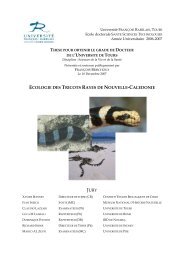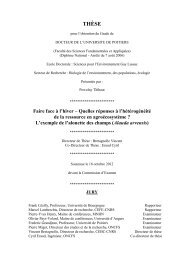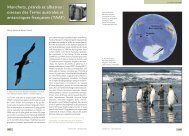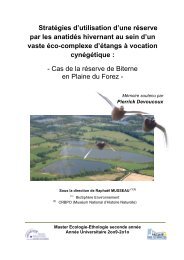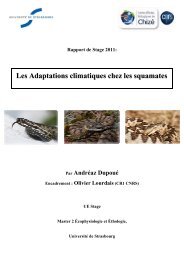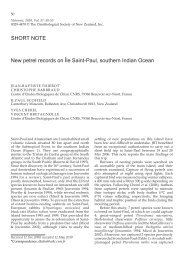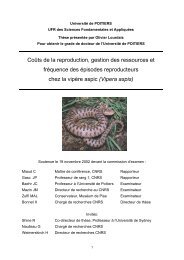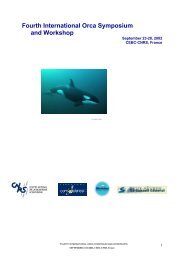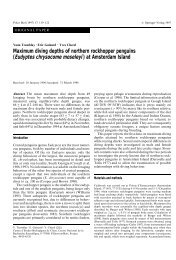Forçage environnemental et prédateurs marins ... - Cebc - CNRS
Forçage environnemental et prédateurs marins ... - Cebc - CNRS
Forçage environnemental et prédateurs marins ... - Cebc - CNRS
You also want an ePaper? Increase the reach of your titles
YUMPU automatically turns print PDFs into web optimized ePapers that Google loves.
686 CHRISTOPHE BARBRAUD AND HENRI WEIMERSKIRCH Ecology, Vol. 86, No. 3<br />
TABLE 1. Selection among models of state-dependent survival probability (S ), recapture probability<br />
(p) and transition probability () on Blue P<strong>et</strong>rels at Kerguelen Islands.<br />
Model np Dev QAIC c i w i<br />
Modeling capture probabilities<br />
r (S , p r, rs<br />
t t t )<br />
r (S , pt, rs<br />
t t )<br />
r (S , p 14, rs<br />
t t t )<br />
r (S , p 14, rs<br />
t t t )<br />
(S , p<br />
90<br />
76<br />
85<br />
78<br />
6699.851<br />
7076.431<br />
6699.851<br />
6709.016<br />
5345.051<br />
5604.819<br />
5334.246<br />
5326.256<br />
89.957<br />
349.725<br />
79.152<br />
71.162<br />
0.000<br />
0.000<br />
0.000<br />
0.000<br />
r r , rs<br />
t t )<br />
Modeling survival probabilities<br />
71 6743.980 5338.221 83.127 0.000<br />
(St, p 14, rs<br />
t t )<br />
(S, p 14, rs<br />
t t )<br />
r (S , p 14, rs<br />
t t t )<br />
23 (S , p 14, rs<br />
t t t )<br />
12 (S , p 14, rs<br />
t t t )<br />
34 (S , p 14, rs<br />
t t t )<br />
52<br />
46<br />
56<br />
55<br />
55<br />
55<br />
6745.725<br />
6762.701<br />
6730.239<br />
6745.239<br />
6733.866<br />
6736.230<br />
5299.446<br />
5299.986<br />
5295.915<br />
5305.362<br />
5296.606<br />
5298.426<br />
44.352<br />
44.892<br />
40.821<br />
50.268<br />
41.512<br />
43.332<br />
0.000<br />
0.000<br />
0.000<br />
0.000<br />
0.000<br />
0.000<br />
Modeling transition probabilities<br />
(S , p , rs r 14<br />
t t )<br />
27 6863.572 5338.395 83.301 0.000<br />
r (S , p 14<br />
t t, t)<br />
31 7580.973 5898.874 643.780 0.000<br />
r (S , p 14, rs<br />
t t t) 34 6749.806 5265.198 10.104 0.006<br />
(S r , p 14, 2434<br />
t t t )<br />
34 6756.545 5270.385 15.291 0.000<br />
(S r , p 14, 1124<br />
t t t )<br />
35 6826.792 5326.525 71.431 0.000<br />
(S r , p 14, 3444<br />
t t t )<br />
35 6776.181 5287.563 32.469 0.000<br />
Modeling covariates<br />
(S r , p 14, rs<br />
SSH t t) 32 6742.031 5255.094 0 0.964<br />
(S r , p 14, rs<br />
mass t t) 32 6753.940 5264.262 9.168 0.010<br />
(S r , p 14, rs<br />
SSHmass t t) 37 6738.805 5262.919 7.825 0.020<br />
(S r , p 14, rs<br />
SSH t SSH) 25 7033.339 5464.993 209.899 0.000<br />
(S r , p 14, rs<br />
SSH t mass) 25 6866.492 5336.550 81.456 0.000<br />
Notes: Model subscripts include: SSH, variation in sea surface height; mass, body mass;<br />
t, a year effect with interaction; t, an additive effect of year (i.e., no interaction). Model<br />
superscripts include: r and s, state-specific param<strong>et</strong>ers; 1, inexperienced nonbreeders; 2, firsttime<br />
breeders; 3, experienced breeders; 4, experienced nonbreeders. Abbreviation are: np,<br />
number of param<strong>et</strong>ers; Dev, relative deviance; QAIC c, Akaïke Information criterion corrected<br />
for ĉ; i, the QAIC c difference b<strong>et</strong>ween the current and lowest QAIC c model; w i, the current<br />
model weight.<br />
GOF statistic for our global model divided by the degrees<br />
of freedom of the model (Pradel <strong>et</strong> al. 2003).<br />
With the inflation factor, the AIC c becomes the quasilikelihood<br />
AIC c (QAIC c, Lebr<strong>et</strong>on <strong>et</strong> al. 1992). We used<br />
program M-SURGE (Choqu<strong>et</strong> <strong>et</strong> al. 2003b) for model<br />
selection and param<strong>et</strong>er estimation.<br />
RESULTS<br />
Goodness-of-fit tests<br />
The GOF test of our general model indicated a lack<br />
of fit (Test3G TestM LRT: 2 223.49, df 172,<br />
P 0.005). The relatively small value of the variance<br />
inflation factor from the global test (ĉ 1.299) was<br />
compatible with overdispersed data. To correct for<br />
overdispersion, we used ĉ 1.299 in the remaining<br />
analysis.<br />
Effect of time, breeding activity, and experience<br />
Recapture probabilities.—We first examined wh<strong>et</strong>her<br />
recapture probabilities varied with state. A model<br />
with no state effect on p (Table 1; [ Sr, p rs<br />
t t, t<br />
]) was not<br />
preferred to the general model ( Sr, r, rs<br />
t pt t<br />
). Because<br />
nests were checked two to three times during the incubation<br />
period to ensure that both partners who al-<br />
ternate incubation shifts were identified, we suspected<br />
that the recapture probabilities of breeders were high<br />
and constant. A model with capture rates constant over<br />
time for breeders and varying for nonbreeders ( Sr, 14<br />
t pt<br />
,<br />
rs t )was much b<strong>et</strong>ter in terms of QAICc than the general<br />
model ( r, r, rs St pt t<br />
). Recapture probability for breeders<br />
was close to 1.0 (0.999; deviance profile confidence<br />
interval: 0.984–1.000). A model in which temporal variations<br />
of recapture probabilities of experienced nonbreeders<br />
and of inexperienced nonbreeders were parallel<br />
on a logit scale ( Sr, 14, rs<br />
t ptt) was preferred over<br />
a model with an interaction b<strong>et</strong>ween state and year<br />
( , , ) or a model with no year effect ( , pr r 14 rs r , rs<br />
St pt t St t<br />
).<br />
This indicated that recapture probabilities of inexperienced<br />
and experienced nonbreeders varied synchronously<br />
over time. For all remaining models, recapture<br />
probabilities were modeled as in model ( Sr, 14, rs<br />
t ptt). For nonbreeders, there was an effect of experience<br />
on recapture probabilities, because experienced individuals<br />
had higher recapture probabilities than inexperienced<br />
ones in all years (pˆ 4 0.527 0.032 and<br />
pˆ 1 0.364 0.019 from model [ , p14 Sr , rs]).<br />
Estimated<br />
t t<br />
probabilities of recapture increased until 1996 for experienced<br />
birds, whereas they remained constant for



